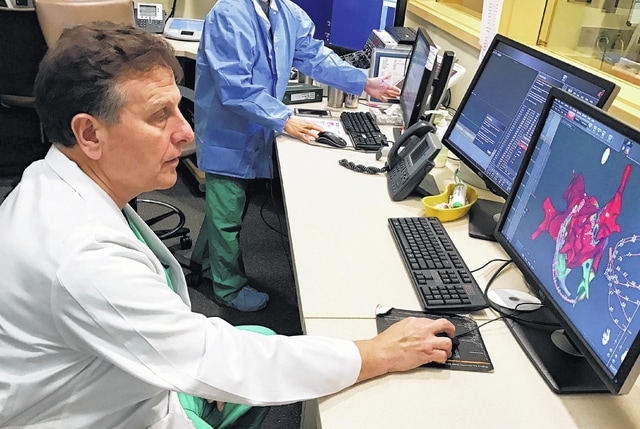Like nearly 6 million other Americans, Morrow County native Richard Hines is living with atrial fibrillation.
A fib, as it is commonly referred to, is a condition that causes the heart to beat irregularly, which can cause blood clots, stroke and other cardiovascular issues.
People living with atrial fibrillation often times notice its symptoms like a rapid and irregular heartbeat or fluttering and “thumping” in the chest. But in cases like Hines’s, the condition went unnoticed.
“I was diagnosed about eight years ago or so,” the Cardington man said. “I didn’t know I had it until I went to a routine physical to renew my CDL.”
After being diagnosed, Hines underwent a procedure known as an ablation in hopes to treat his atrial fibrillation.
The process involves surgeons creating tiny scars on a patient’s heart to disrupt the abnormal signals that causes an irregular heart beat.
The Morrow County native received two rounds of ablation treatments that were largely unsuccessful before he was referred to The Ohio State University Wexner Medical Center for a unique procedure designed to pinpoint trouble areas in the heart.
Scientists here are studying revived human atria and translating their findings to improve treatment.
“This will allow us to map the heart more completely and eventually may help us personalize our procedures according to each patient’s individual needs,” said Dr. John Hummel, director of clinical electrophysiology research at Ohio State Wexner Medical Center. “While it’s still in the early stages, the work Dr. Fedorov is doing with human heart tissue is the kind of thing that will make pivotal changes in our ability to manage patients’ diseases in the coming years.”
The technique was created by Vadim Fedorov, an associate professor in Ohio State’s Department of Physiology and Cell Biology.
Once a donated heart is received, Fedorov’s team has 12 hours to prepare the atria and collect data. The heart tissue is placed in a dish surrounded by four highly-sensitive infrared cameras, and a fluorescent dye that can sense electrical activity is injected.
“We can see 40,000 recordings across the heart and we can visualize the electrical activity in 3D. We can see through the heart. We can see at many different depths. It’s a vast improvement over any current clinical imaging, where you see up to 200 recordings, and only from one side,” Fedorov said.
That improvement in imaging has given way to more individually tailored ablation procedures for patients like Hines.
“It’s like we were in the dark and then somebody turned the lights on,” the Cardington man said of the new treatment procedure.
With “the lights on” doctors are able to make more accurate incisions during the ablation process.
Hines was able to receive a new and improved ablation last fall and hopes that will be the last round of treatment he will need to combat his a-fib.
As for now he monitors his heart at his home, sending the readings remotely to the team at OSU.

Part of a donated human heart is reanimated and recorded with four high-definition optic cameras in a laboratory at The Ohio State University Wexner Medical Center. Researchers keep the heart tissue alive to look for the causes of irregular heartbeats in cases of persistent atrial fibrillation.

Researchers at The Ohio State University Wexner Medical Center developed a technique to revive parts of donated human hearts in the laboratory to search for hidden sources of irregular heartbeats.

Dr. John Hummel looks at the images of a patient’s heart at The Ohio State University Wexner Medical Center. Hummel is teaming up with scientists who are able to keep portions of donated human hearts alive in a laboratory, while they search for hidden sources of irregular heartbeats.





